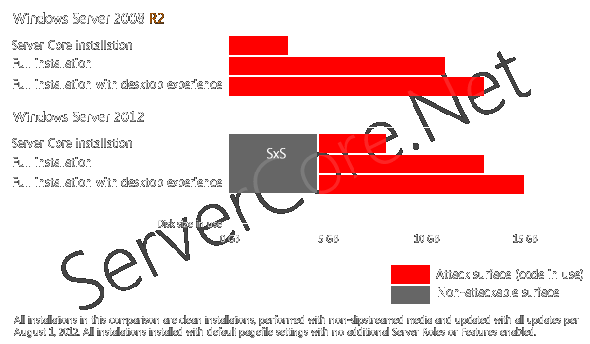Posted by Sander Berkouwer on September 19th, 2011 |
3 commentsThis post covers a pre-release product and was written in September 2011. The actual product may not reflect the behavior, specifications or intentions found in this post. Use with caution.
Microsoft showed off Windows Server 8 at the second day of the //Build/ conference last week. In the session named SAC-416T, Andrew Mason (Principal Group Program Manager for Server Core) and Jeffrey Snover (Distinguished Engineer and Lead Architect of Windows Server) introduced the plans with user interface options in Windows 8.
A little bit of recent history…
Whereas Windows Server 2008 and Windows Server 2008 R2 offer the Server Core installation option, to minimize the burden of Graphical User Interfaces (GUIs), according to Microsoft, this was an ideal situation.
Windows Server 2008
As you might remember, Server Core was introduced as an installation option for Windows Server in Windows Server 2008. As a systems administrator you could choose this option at installation and you needed to stick with your choice. This choice meant you had trouble installing applications (like UPS management, backup and antivirus tools) and management was spotty without PowerShell. Also, one of the places where security mattered most could not be addressed within Server Core: Servers running dynamic (ASP.Net based) websites.
Windows Server 2008 R2
With the release Microsoft improved the Server Core installation option significantly. Now you could make most ASP.Net-based websites work on server Core, roughly 230 PowerShell cmdlets were introduced and most producers of management, UPS and antivirus products had awoken to the idea of Windows Server without Windows.
Windows Server 8
With Windows Server 8, Microsoft ups the game. Windows PowerShell now boosts a tenfold more cmdlets. An installation option was deemed insufficient, so the option to switch between the Server Core and Full installation gets introduced. Furthermore, Microsoft will introduce a new flavor between the Server Core installation and the Full installation. This is called the ‘Features on Demand’ option.
These three flavors can already be found when installing the Windows Server 8 Developer Preview (build 8102):

This screen during the Windows server setup now loses a lot of importance, since you can switch between the three flavors after the Operating System is installed.
Differences between the three interface options
The differences between these three flavors is described in the following table:
|
Server Core Installation
|
Features on Demand
|
Full Installation
|
| Windows Core |
o
|
o
|
o
|
| Windows PowerShell |
o
|
o
|
o
|
| .Net Framework 4 |
o
|
o
|
o
|
| Server Manager |
|
o
|
o
|
| Microsoft Management Consoles |
|
o
|
o
|
| A subset of Control Panel Applets |
|
o
|
|
| All Control Panel Applets |
|
|
o
|
| Windows Help |
|
|
o
|
| Windows Explorer |
|
|
o
|
| Internet Explorer |
|
|
o
|
Guidance
Andrew and Jeffrey delivered the message ‘Server Core is the preferred deployment configuration’ strongly. This single sentence even received it’s own PowerPoint slide to illustrate the point. A Server Core installation requires the least amount of resources, time and patches of all Windows Server installation options.
But no longer, will you need to deploy your server as a Server Core installation. From Windows Server 8, you will be able to install Windows Server either as a Full Installation or Features on Demand Installation and when done trim down the Windows Server installation to a Server Core installation, where possible.
If all your agents and applications support Server Core and you don’t need any of the MMCs or Control Panel Applets, or you can reproduce your advanced settings through the registry, APIs, Remotely or through WS-Management, you can install Server Core from the start, offering you a superb deployment experience with the least amount of deployment traffic.
Concluding
Microsoft unfolded a strategic view on the interface options in Windows Server 8. You can now choose between a Server Core installation, a Features on Demand Installation and a Full Installation, each offering more Graphical User Interface elements.
No longer do you need to make this choice at the installation of the Windows Server Operating System. You can switch between the three interface options after installation, offering huge flexibility and security in the long run.
Further reading
Windows Server 8 apps must run without a GUI – learn more now
Microsoft Unveils Windows Server 8
Windows Server 8 will bring us this!
10 best new features of Windows Server 8
Windows Server 8: Now with added VMware and Unix
Windows Server 8 should be full of surprises
Microsoft provides more details about Windows Server 8
 Last week, Microsoft has released a KnowledgeBase article titled Errors connecting to Windows Server 2008 R2 or Windows Server 2012 Device Manager remotely.
Last week, Microsoft has released a KnowledgeBase article titled Errors connecting to Windows Server 2008 R2 or Windows Server 2012 Device Manager remotely. With Windows Server 2012, Microsoft has changed its Server Core strategy. In short, Microsoft now focuses on the flexibility to switch the Graphical User Interface (GUI) from a full installation to a minimal shell and even further down to server core, instead of reducing the disk space needed to run the Operating System. (the ‘disk foot print’)
With Windows Server 2012, Microsoft has changed its Server Core strategy. In short, Microsoft now focuses on the flexibility to switch the Graphical User Interface (GUI) from a full installation to a minimal shell and even further down to server core, instead of reducing the disk space needed to run the Operating System. (the ‘disk foot print’)
